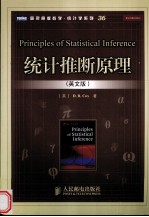图书介绍
统计推断原理 英文版【2025|PDF|Epub|mobi|kindle电子书版本百度云盘下载】

- (英)D·R·Cox著 著
- 出版社: 北京:人民邮电出版社
- ISBN:9787115210746
- 出版时间:2009
- 标注页数:220页
- 文件大小:10MB
- 文件页数:234页
- 主题词:统计推断-英文
PDF下载
下载说明
统计推断原理 英文版PDF格式电子书版下载
下载的文件为RAR压缩包。需要使用解压软件进行解压得到PDF格式图书。建议使用BT下载工具Free Download Manager进行下载,简称FDM(免费,没有广告,支持多平台)。本站资源全部打包为BT种子。所以需要使用专业的BT下载软件进行下载。如BitComet qBittorrent uTorrent等BT下载工具。迅雷目前由于本站不是热门资源。不推荐使用!后期资源热门了。安装了迅雷也可以迅雷进行下载!
(文件页数 要大于 标注页数,上中下等多册电子书除外)
注意:本站所有压缩包均有解压码: 点击下载压缩包解压工具
图书目录
Example 1.1 The normal mean3
Example 1.2 Linear regression4
Example 1.3 Linear regression in semiparametric form4
Example 1.4 Linear model4
Example 1.5 Normal theory nonlinear regression4
Example 1.6 Exponential distribution5
Example 1.7 Comparison of binomial probabilities5
Example 1.8 Location and related problems5
Example 1.9 A component of variance model11
Example 1.10 Markov models12
Example 2.1 Exponential distribution(ctd)19
Example 2.2 Linear model(ctd)19
Example 2.3 Uniform distribution20
Example 2.4 Binary fission20
Example 2.5 Binomial distribution21
Example 2.6 Fisher's hyperbola22
Example 2.7 Binary fission(ctd)23
Example 2.8 Binomial distribution(ctd)23
Example 2.9 Mean of a multivariate normal distribution27
Example 3.1 Test of a Poissonmean32
Example 3.2 Adequacy of Poisson model33
Example 3.3 More on the Poisson distribution34
Example 3.4 Test of symmetry38
Example 3.5 Nonparametric two-sample test39
Example 3.6 Ratio of normal means40
Example 3.7 Poisson-distributed signal with additive noise41
Example 4.1 Uniform distribution of known range47
Example 4.2 Two measuring instruments48
Example 4.3 Linear model49
Example 4.4 Two-by-two contingency table51
Example 4.5 Mantel-Haenszel procedure54
Example 4.6 Simple regression for binary data55
Example 4.7 Normal mean,variance unknown56
Example 4.8 Comparison of gamma distributions56
Example 4.9 Unacceptable conditioning56
Example 4.10 Location model57
Example 4.11 Normal mean,variance unknown(ctd)59
Example 4.12 Normal variance59
Example 4.13 Normal mean,variance unknown(ctd)60
Example 4.14 Components of variance61
Example 5.1 Exchange paradox67
Example 5.2 Two measuring instruments(ctd)68
Example 5.3 Rainy days in Gothenburg70
Example 5.4 The normal mean(ctd)71
Example 5.5 The noncentral chi-squared distribution74
Example 5.6 A set of binomial probabilities74
Example 5.7 Exponential regression75
Example 5.8 Components of variance(ctd)80
Example 5.9 Bias assessment82
Example 5.10 Selective reporting86
Example 5.11 Precision-based choice of sample size89
Example 5.12 Sampling the Poisson process90
Example 5.13 Multivariate normal distributions92
Example 6.1 Location model(ctd)98
Example 6.2 Exponential family98
Example 6.3 Transformation to near location form99
Example 6.4 Mixed parameterization of the exponential family112
Example 6.5 Proportional hazards Weibull model113
Example 6.6 A right-censored normal distribution118
Example 6.7 Random walk with an absorbing barrier119
Example 6.8 Curved exponential family model121
Example 6.9 Covariance selection model123
Example 6.10 Poisson-distributed signal with estimated background124
Example 7.1 An unbounded likelihood134
Example 7.2 Uniform distribution135
Example 7.3 Densities with power-law contact136
Example 7.4 Model of hidden periodicity138
Example 7.5 A special nonlinear regression139
Example 7.6 Informative nonresponse140
Example 7.7 Integer normal mean143
Example 7.8 Mixture of two normal distributions144
Example 7.9 Normal-theory linear model with many parameters145
Example 7.10 A non-normal illustration146
Example 7.11 Parametric model for right-censored failure data149
Example 7.12 A fairly general stochastic process151
Example 7.13 Semiparametric model for censored failure data151
Example 7.14 Lag one correlation of a stationary Gaussian time series153
Example 7.15 A long binary sequence153
Example 7.16 Case-control study154
Example 8.1 A new observation from a normal distribution162
Example 8.2 Exponential family165
Example 8.3 Correlation between different estimates165
Example 8.4 The sign test166
Example 8.5 Unbiased estimate of standard deviation167
Example 8.6 Summarization of binary risk comparisons171
Example 8.7 Brownian motion174
Example 9.1 Two-by-two contingency table190
1 Preliminaries1
Summary1
1.1 Starting point1
1.2 Role of formal theory of inference3
1.3 Some simple models3
1.4 Formulation of objectives7
1.5 Two broad approaches to statistical inference7
1.6 Some further discussion10
1.7 Parameters13
Notes 114
2 Some concepts and simple applications17
Summary17
2.1 Likelihood17
2.2 Sufficiency18
2.3 Exponential family20
2.4 Choice of priors for exponential family problems23
2.5 Simple frequentist discussion24
2.6 Pivots25
Notes 227
3 Significance tests30
Summary30
3.1 General remarks30
3.2 Simple significance test31
3.3 One-and two-sided tests35
3.4 Reladon with acceptance and rejection36
3.5 Formulation of alternatives and test statistics36
3.6 Relation with interval estimation40
3.7 Interpretation of significance tests41
3.8 Bayesian testing42
Notes 343
4 More complicated situations45
Summary45
4.1 General remarks45
4.2 General Bayesian formulation45
4.3 Frequentist analysis47
4.4 Some more general frequentist developments50
4.5 Some further Bayesian examples59
Notes462
5 Interpretations of uncertainty64
Summary64
5.1 General remarks64
5.2 Broad roles of probability65
5.3 Frequentist interpretation of upper limits66
5.4 Neyman-Pearson operational criteria68
5.5 Some general aspects of the frequentist approach68
5.6 Yet more on the frequentist approach69
5.7 Personalistic probability71
5.8 Impersonal degree of belief73
5.9 Reference priors76
5.10 Temporal coherency78
5.11 Degree of belief and frequency79
5.12 Statistical implementation of Bayesian analysis79
5.13 Model uncertainty84
5.14 Consistency of data and prior85
5.15 Relevance of frequentist assessment85
5.16 Sequential stopping88
5.17 A simple classification problem91
Notes 593
6 Asymptotic theory96
Summary96
6.1 General remarks96
6.2 Scalar parameter97
6.3 Multidimensional parameter107
6.4 Nuisance parameters109
6.5 Tests and model reduction114
6.6 Comparative discussion117
6.7 Profile likelihood as an information summarizer119
6.8 Constrained estimation120
6.9 Semi-asymptotic arguments124
6.10 Numerical-analytic aspects125
6.11 Higher-order asymptotics128
Notes 6130
7 Further aspects of maximum likelihood133
Summary133
7.1 Multimodal likelihoods133
7.2 Irregular form135
7.3 Singular information matrix139
7.4 Failure of model141
7.5 Unusual parameter space142
7.6 Modified likelihoods144
Notes 7159
8 Additional objectives161
Summary161
8.1 Prediction161
8.2 Decision analysis162
8.3 Point estimation163
8.4 Non-likelihood-based methods169
Notes 8175
9 Randomization-based analysis178
Summary178
9.1 General remarks178
9.2 Sampling a finite population179
9.3 Design of experiments184
Notes 9192
Appendix A:A brief history194
Appendix B:Apersonal view197
References201
Author index209
Subject index213
热门推荐
- 1507465.html
- 2381399.html
- 707106.html
- 2234361.html
- 3262222.html
- 2661982.html
- 2990142.html
- 2560217.html
- 3635750.html
- 2700657.html
- http://www.ickdjs.cc/book_452141.html
- http://www.ickdjs.cc/book_1672642.html
- http://www.ickdjs.cc/book_2645436.html
- http://www.ickdjs.cc/book_1984395.html
- http://www.ickdjs.cc/book_1181284.html
- http://www.ickdjs.cc/book_873612.html
- http://www.ickdjs.cc/book_2803304.html
- http://www.ickdjs.cc/book_3342628.html
- http://www.ickdjs.cc/book_589263.html
- http://www.ickdjs.cc/book_3137793.html